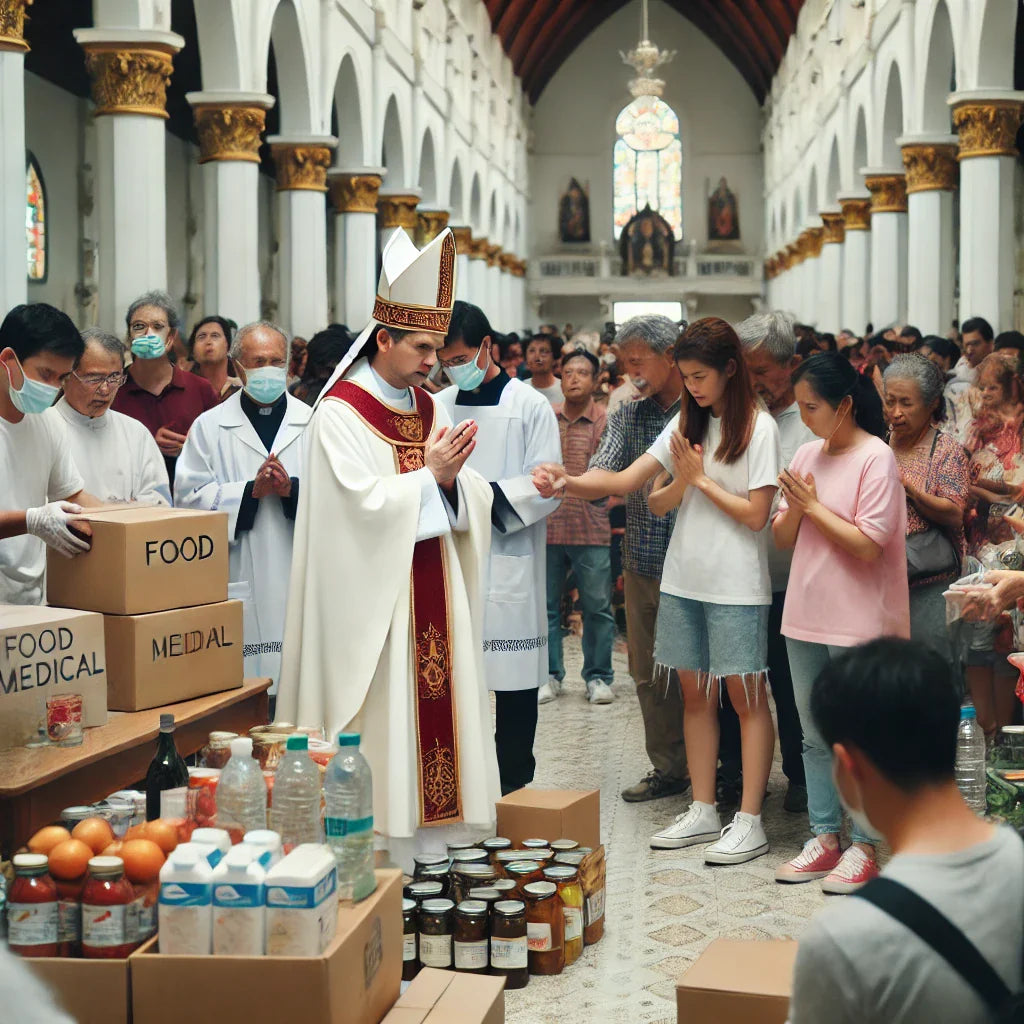
Church Responses to Pandemic and Crisis
|
|
Time to read 4 min
|
|
Time to read 4 min
The COVID-19 pandemic and various natural disasters have posed unprecedented challenges to communities worldwide. For the Catholic Church in India, these crises became an opportunity to demonstrate resilience, compassion, and unwavering commitment to service. Across Indian dioceses, churches mobilized resources, extended charitable aid, and adapted worship practices to continue ministering to the faithful.
This article explores how Indian dioceses responded to the COVID-19 pandemic and other crises, highlighting the Church’s role in providing relief, ensuring pastoral care, and adapting to new realities. It also presents key lessons learned that can guide future crisis responses.
As the pandemic spread, dioceses had to suspend public Masses and religious gatherings to prevent the virus's transmission. To keep the faithful spiritually nourished:
Live-streamed Masses were introduced via YouTube, Facebook, and parish websites.
Drive-in Masses allowed worshippers to participate in the Eucharist while maintaining social distancing.
Online prayer services and daily scripture reflections were offered through WhatsApp groups and diocesan apps.
The adaptation to digital worship allowed believers to remain connected with their faith despite the physical separation. It also opened opportunities for the Church to reach people who had never attended in-person services, expanding the reach of evangelization. In addition, this shift emphasized the importance of media literacy among church leaders, leading to new training programs on digital engagement and communication strategies.
Churches collaborated with local health authorities to promote safety protocols:
Parish centers were used as vaccination and testing sites .
Clergy and volunteers distributed masks, sanitizers, and health kits .
Faith-based mental health counseling was provided for those struggling with isolation and anxiety.
Additionally, many churches launched awareness campaigns using digital platforms to educate communities on pandemic safety measures. Priests and nuns worked with medical professionals to dispel misinformation and encourage vaccination drives, particularly in rural areas where skepticism was prevalent. The Church’s active role in promoting public health strengthened trust and collaboration between faith-based institutions and healthcare providers.
During lockdowns and economic disruptions, many families struggled with food insecurity. Indian dioceses launched numerous initiatives:
Community kitchens run by churches provided daily meals to migrants and the unemployed.
Parish-based food banks collected and distributed groceries to families in need.
Collaboration with NGOs and government agencies ensured wider reach and effective relief efforts.
The role of volunteers and youth ministries was critical in the implementation of these relief efforts. Young Catholics played a key role in door-to-door food distribution and assisting in logistics, demonstrating the Church’s commitment to empowering its members to be agents of change. This not only helped provide immediate relief but also strengthened a culture of service among the younger generation.
Recognizing the sacrifice of medical professionals, dioceses:
Provided free accommodations in convents and church facilities for frontline workers.
Supplied protective equipment (PPE kits, gloves, face shields) to hospitals.
Organized prayer chains and online blessings for healthcare staff.
Some dioceses even partnered with Catholic medical institutions to set up temporary COVID-19 care centers, offering oxygen supplies and emergency beds for those who couldn’t access hospital care. The unity between the Church and medical professionals reinforced the spirit of solidarity, ensuring that faith and healthcare worked together to save lives.
Many parishes set up relief funds to support families affected by job losses. Special collections were held to:
Help cover medical expenses for COVID-19 patients.
Support funeral costs for families who lost loved ones.
Assist daily wage laborers and small business owners facing financial hardship.
Church-run microfinance initiatives were also introduced in some regions to help struggling families rebuild their livelihoods post-pandemic. These initiatives aimed to promote self-sufficiency by providing small loans and vocational training, allowing communities to recover with dignity.
With in-person gatherings limited, churches embraced digital platforms to maintain community bonds:
Online Bible studies and prayer groups provided spiritual nourishment.
Youth ministries used Instagram and Zoom to engage younger members.
Virtual retreats and counseling services offered emotional and spiritual guidance.
Moreover, priests and nuns actively engaged with parishioners through personal video messages and calls, ensuring that no one felt abandoned during the crisis. For many elderly individuals living alone, these interactions became a crucial source of emotional support, reinforcing the Church’s mission of care and companionship.
Recognizing that crisis affects all communities, Catholic dioceses worked alongside:
Other Christian denominations in joint relief programs .
Hindu, Muslim, and Sikh organizations in interfaith charity efforts .
Government and secular agencies to coordinate aid distribution .
These interfaith collaborations not only facilitated relief efforts but also strengthened communal harmony, showcasing the Church’s commitment to serving humanity beyond religious boundaries.
India frequently faces natural disasters such as cyclones and floods. Catholic dioceses played a critical role in:
Providing temporary shelter in parish halls and schools for displaced families.
Distributing relief materials , including blankets, clean water, and food supplies.
Mobilizing volunteers for cleanup and rebuilding efforts in affected areas.
After immediate relief work, the Church continued to support long-term recovery by:
Assisting with livelihood restoration through skill training programs.
Providing educational aid for children affected by disasters.
Advocating for government support and fair compensation for victims.
The Catholic Church in India has exemplified resilience, charity, and adaptability in responding to the COVID-19 pandemic and natural disasters. By leveraging technology, fostering interfaith cooperation, and expanding charitable initiatives, Indian dioceses have provided a model for future crisis responses.
Moving forward, these lessons can guide a more prepared and proactive approach, ensuring that faith communities remain sources of hope and support in times of uncertainty. The Church’s commitment to humanitarian work and spiritual leadership will continue to be a beacon of light for those in need.